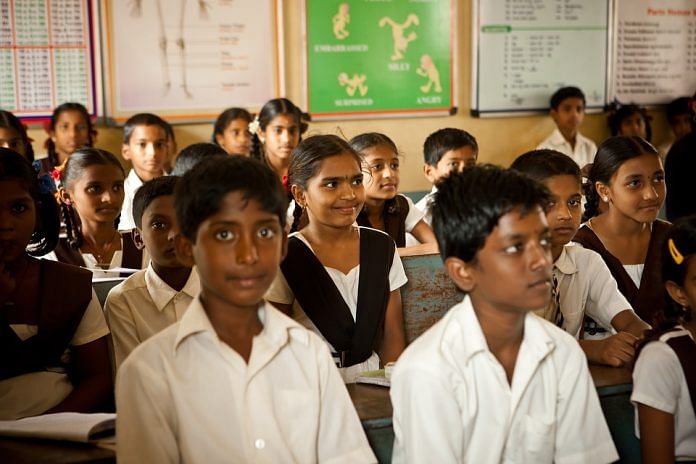The first assessment of 14-18 year olds shows girls abandoning school much more than boys; Chief Economic Advisor Arvind Subramanian says he’s worried.
New Delhi: For the last 11 years, the Annual Status of Education Report (Rural) on school education showed that there was parity between the number of 6-10-year-old girls and boys who were enrolled in or had dropped out of school. This indicated that girls and boys did equally well or poorly on various reading, writing, mathematical and comprehension abilities.
The latest ASER report, however, marks a clean shift. Chief Economic Advisor Arvind Subramanian, in fact, has described it as the first sign of a sharp “wedge” opening up in the school-going population of India.
The first ASER assessment of 14-18 year olds shows girls abandoning school in significantly large numbers beyond 14 years of age. By age 18, 4.3 per cent more girls have dropped out of school than boys. What’s even more alarming is that even the girls who stay enrolled appear to be falling behind the boys on almost every learning parameter.
“Although having completed at least eight years of schooling is an advantage, not all youth who have done so can do these tasks. Females perform worse than males on almost all tasks,” states the ASER 2017 report.
Failing basic tasks
Many tasks referred to above are of Class 2 level.
Consider this – while 89.4 per cent of males in the 14-18 age group could recognise the map of India, only 83.6 per cent females could. While 69.1 per cent males could name India’s capital, just 59.7 per cent females could.
On mathematical abilities, 60.5 per cent females were unable to perform division, as against 52.9 per cent males. Just 28.7 per cent females were able to apply a discount compared to 46.7 per cent boys. Sixty per cent of girls were able to do financial calculations on managing a budget or taking a purchase decision, as against 67.4 per cent boys.
Girls did better than boys in reading small letters and words in English, but boys were several percentage points higher in reading sentences.
“If this refers to abilities of Class 2 level – where this wedge is opening up – where are we heading from here?” Chief Economic Advisor Subramanian asked as he shared his thoughts on the ASER report.
Household work and other compulsions
Girls dropping out of school as they hit puberty is a well-recorded phenomenon, and the unavailability of toilets has been cited as one reason. Other reports have recently pointed out to the inordinate burden of household work that girls are faced with, and how it can affect their time allocation for school work.
The ASER reports shows that 89.4 per cent of 14-18 year old girls did household work on a daily basis, as against 76.8 per cent boys. This means even if a girl is able to retain the right to go to school, it does not necessarily exempt her from her chores as the girl child.
It doesn’t just stop there – 76 per cent of girls surveyed had never used the internet, as opposed to 49 per cent boys. While 22 per cent girls had never used a mobile phone, the figure for boys was 12 per cent.
Professional aspirations also continue to indicate a clear gender bias – males aimed to join the army, police or engineering, while the females indicated preference for teaching and nursing careers.
Of second chances
But what about the teenage girls who drop out of school?
The report notes that one of every three girls dropping out pointed to her family’s reluctance to let her study further – more so than distance, security and financial constraints.
ASER researchers also note that nearly 5 per cent of the 30,000 young people surveyed for this report were found in a ‘doing nothing’ situation – not working, studying or preparing to work or study. Of these, three-fourths were found to be young women.
The survey draws up a distressing portrait of many youngsters simply refusing to answer any questions or even attempting them. And it was a higher proportion of girls than boys who were non-responsive. ASER researcher Suman Bhattacharjea mentions one such girl, Rita – out of school and determinedly refusing to entertain any thought of a life beyond the household.
At the other end of this spectrum are those ASER Foundation CEO Rukmini Banerjee calls “second chance girls” – those who may have dropped out of school due to constraints but are trying hard to make a comeback.
This is clearly the new challenge facing India’s education sector. While the governments may have got little girls and boys to school, and will probably retain them until Class 8 with the Right to Education Act in effect, what after that? How will Rita get a second chance?
That is the question raised by ASER 2017, and that is one that needs to be answered before the “wedge” widens.







Үes! Finally something about crash.
I don’t know if it’s just me or if everybody else
experiencing issues with your site. It seems like some of the text on your
content are running off the screen. Can somebody else please provide
feedback and let me know if this is happening
to them too? This might be a problem with my internet browser because I’ve
had this happen before. Thanks